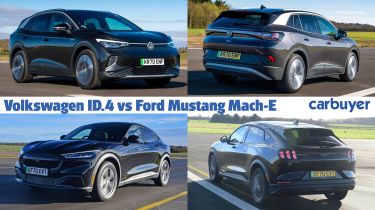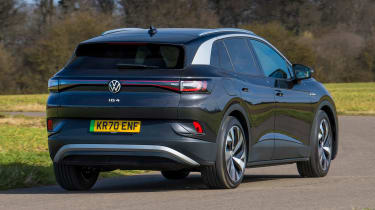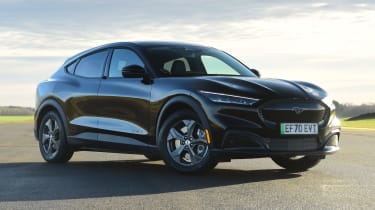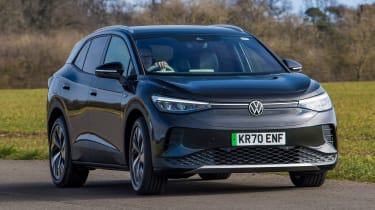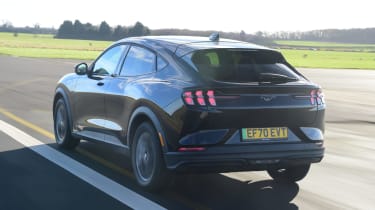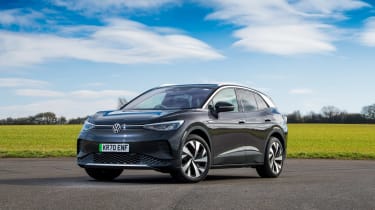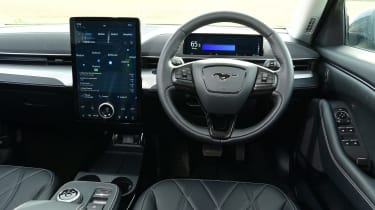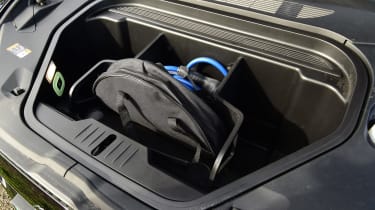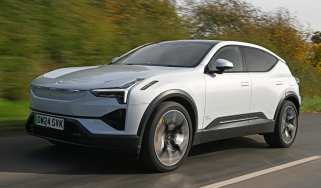Volkswagen ID.4 vs Ford Mustang Mach-E - rivals comparison
Both cars are significant entrants into the electric SUV market but which one should you buy?
The Volkswagen ID.4 and Ford Mustang Mach-E are important models for their respective manufacturers, giving both a foothold in the growing and increasingly competitive electric SUV market.
The Volvo XC40 P8 Recharge, Audi e-tron, Mercedes EQC and Jaguar I-Pace are already leading the charge in the electric SUV sector but they’re upmarket cars that come with a premium price tag. The ID.4, however, is one of the first mainstream models to enter the market, giving buyers a more affordable electric alternative to conventional or plug-in hybrid variants.
 Top 10 best electric SUVs – the ones to buy in 2025
Top 10 best electric SUVs – the ones to buy in 2025
The ID.4 shares much of its design with the smaller ID.3 and is one of the cheapest electric SUVs you can buy, with prices starting from £32,150. It sits between the Volkswagen Tiguan and seven-seat Volkswagen Tiguan Allspace in size and counts the Tesla Model Y and the Mustang Mach-E as close rivals.
The Mustang Mach-E is the first purpose-built electric car from Ford and gives us an insight into how the American car giant plans to move away from the internal combustion engine and into the new electric era. Like the ID.4, the Mustang Mach-E is designed to take on models such as the Tesla Model Y and Model 3, along with the Skoda Enyaq iV and Jaguar I-Pace, but it’s more expensive, with the entry-level model available from £41,250.
Prices and specs
ID.4 customers can choose from six trim levels called City, Style, 1st Edition, Life, Family and Max. The City, being the cheapest model in the range, is the only model to qualify for the government’s plug-in car grant at £32,150. The Style variant is priced at £38,150 and comes with more standard equipment.
The mid and range-topping models are significantly more expensive than the newly introduced base models. The 1st Edition is available from £40,800, the Life £41,570, the Family £45,520 and the Max £49,990. The range-topping models come with the higher spec powertrain, which partly explains the price difference.
As with the ID.3, Volkswagen also offers fixed equipment packs across the range to simplify the ordering process for customers. The Interior Style Package adds 30-colour ambient lighting, split-folding rear seats and ‘play and pause’ pedals. The Infotainment Package features a 10-inch Discover Pro touchscreen system with sat nav and inductive smartphone charging. Finally, the Comfort Package brings a heated windscreen, two front and rear USB ports, two-zone climate control, and heated front seats and steering wheel.
The Mustang Mach-E gets a generous amount of equipment as standard and the lineup is simpler than the ID.4’s range. The Mach- E is available in two Standard Range and two Extended range models. The cheapest of the range is priced at £41,250, while the most expensive has a price tag of £56,950.
The Mach-E Standard Range models feature automatic headlights, all-round parking sensors, adaptive cruise control, dual-zone climate control, heated seats and steering wheel, and a rear-view camera. Extended Range models, meanwhile, get a 360-degree camera system, panoramic sunroof, B&O stereo system, powered hands-free tailgate and automatic parking. There's also a First Edition model, which is available in Grabber Blue, Carbonised Grey or Rapid Red paint finishes.
Ford does offer a number of options for the Mustang Mach-E. Buyers can choose to upgrade from the standard Absolute Black body colour to “Premium” paint finishes, which start from around £800, or “Exclusive” colours, which can increase the price by around £1,150. Buyers can also choose from a range of other cosmetic and functional upgrades, including a detachable tow bar package, available from £500, and a rear-mounted ski carrier for £250.
Range and performance
Both the ID.4 City and Style variants are available with powertrains called Pure and Pure Performance, which both use a 52kWh battery. The rest of the lineup, meanwhile, is only available with the Pro Performance powertrain, which uses a larger 77kWh battery. The Pure powertrain is matched to a 146bhp electric motor, while the sportier Pure Performance version has 168bhp.
In City guise, the ID.4 offers 213 miles of range on a full charge, while the Style can achieve up to 211 miles. The Pro Performance powertrain’s battery is linked to a single, rear-mounted electric motor, which produces a punchier 201bhp and 310Nm of torque. This setup gives the ID.4 a 0-62mph time of 8.2 seconds and a top speed of 99mph.
In Life guise, the ID.4 is capable of 323 miles on a full charge but this figure falls to 318 and 314 miles for the Family and Max variants respectively. All versions come with 100kW rapid charging capability and Volkswagn says the ID.4 can regain up to 199 miles of range from a 125kW rapid charger in just 30 minutes. When using a 7.2kW home charger, however, a full charge takes around 11 hours.
Like the ID.4, Ford is offering customers a choice of battery sizes to accommodate for different lifestyles and budgets. The smallest 68kWh (usable) battery, provides a range of up to 273 miles with two-wheel drive, dropping to 248 miles with a dual motor, four-wheel drive setup. The more expensive version, meanwhile, uses an 88kWh (usable) battery, offering up to 379 miles of range with rear-wheel drive. This figure drops to 335 miles in dual-motor, four-wheel-drive setup.
The Standard Range rear-wheel drive Mach-E produces 266bhp, while the Extended Range model generates 290bhp, increasing to 346bhp with a dual-motor setup. The most basic rear-wheel-drive model, using a single motor, can complete the 0-62mph sprint in 6.9 seconds, while the more powerful range-topper takes an even speedier 5.1 seconds.
The Mach-E also features three driving modes that the driver can choose based on weather, terrain and driving style. Active is the middle-of-the-road default setting, while Whisper favours driving range and softens the throttle response. Untamed sharpens throttle response to make acceleration more instant and adds fake V8 engine sounds.
Like all pure-electric cars, the ID.4 and Mach-E are tax exempt and owners can enjoy free access to low emissions zones and cities.
Styling
The ID.4 gets a bold, more modern look in comparison to the larger and more conservative Tiguan. It features 20-inch alloy wheels, sleek body lines and full-width front and rear lights. The ID.4’s SUV-style plastic wheel arches and side skirts give it a slightly rugged look.
The Mach-E, meanwhile, provokes some strong reactions thanks to the use of the iconic Mustang badge and its unusual looks. Its coupe-like shape combined with wide rear haunches and Mustang tail lights hint at the car’s performance, and there’s no doubting that the Mustang Mach-E is a striking car.
If anything, the Mustang Mach-E’s daring design shows how far Ford was prepared to go to ensure its first proper electric car was desirable - and one that would demand attention.
Interior
The ID.4 features a clean, minimalist interior, with very few physical buttons but some cheaper plastics hint at cost-cutting. Despite that, the ID.4 is clearly meant to feel more upmarket than the ID.3. The cabin is dominated by an infotainment setup that consists of a large central touchscreen and a smaller driver's display behind the steering wheel. It’s quite a complex system and even the simplest functions take more effort than is desired.
Step inside the Mustang Mach-E and you won’t feel like you’re in a Ford; the interior is clearly inspired by those we’ve already seen in Tesla’s cars. The dashboard is dominated by a huge 15.5-inch portrait touchscreen, and there's also a 10.2-inch digital instrument cluster behind the steering wheel.
Range-topping versions of the Mach-E cost close to £60,000, so Ford needed to create an interior worthy of such a high price tag. You’ll notice familiar Ford switches and indicator stalk but a fabric and carbon-style trim for the dashboard give it a premium, luxury feel - and it’s ahead of anything else available in Ford’s range.
Practicality
The ID.4 is 75mm longer than a Volkswagen Tiguan, helping to make it one of the most spacious SUVs on the market. Since most of the car’s powertrain is packaged neatly in the floor, front and rear-seat passengers benefit from heaps of space, especially in the head, knee and legroom departments. It's much more spacious than a Kia e-Niro, allowing for even tall adults to get comfortable in the back. It’s the same story for the Mustang Mach-E; even with a panoramic glass roof fitted, it's possible for six-footers to get comfortable in the rear and there are plenty of storage trays and side-by-side cup holders for those in the front seats.
The ID.4 boasts a 543-litre boot behind its rear seats but if you fold them down this increases to 1,655 litres. It's bigger than the Mustang Mach-E’s 402 litres but the ID.4 doesn’t get a 'frunk' under its bonnet, like the Mach-E’s additional 81-litre storage space, which can increase to 100 litres when the storage divider is removed. Both cars get a dedicated compartment for their charging cables under the boot floor, so you can neatly store them away when they’re not in use.
Neither Volkswagen or Ford have released exact towing specifications yet but we predict that both cars should be able to tow at least 750kg. It’s important to note that EVs aren’t able to tow as much as conventional electric, petrol or hybrid models. If towing a caravan or horsebox is a necessity for you, then we’d suggest looking at the Ford Kuga PHEV, which can tow up to 1,200kg.
Verdict
While both these electric SUVs are similar in offering a great deal of technology, practicality and performance, they’re actually quite different. Volkswagen has introduced a mainstream contender that appeals to a broader customer base, thanks to its lower price and the entry-level model’s qualification for the government’s plug-in car grant.
Ford, meanwhile, appears to have launched its Mach-E slightly more upmarket to target Tesla, and the car is more expensive as a result. The ID.4 may not be as distinct as the Mach-E but it offers the comfort and equipment we’d expect from an SUV, is good to drive, offers a competitive range and costs less. For those reasons, the ID.4 is our choice.
Interested in an electric car? Check out our Best Electric Cars page.
Recommended
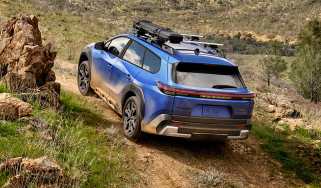
New Subaru Trailseeker revealed as rugged electric SUV with 375bhp
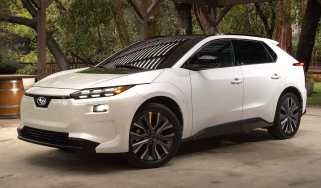
New Subaru Solterra brings more range, power and polish
Most Popular
Tips & advice

Car dashboard warning lights: what does each symbol mean?

Electric car charging stations: public networks, charger types, apps and maps

